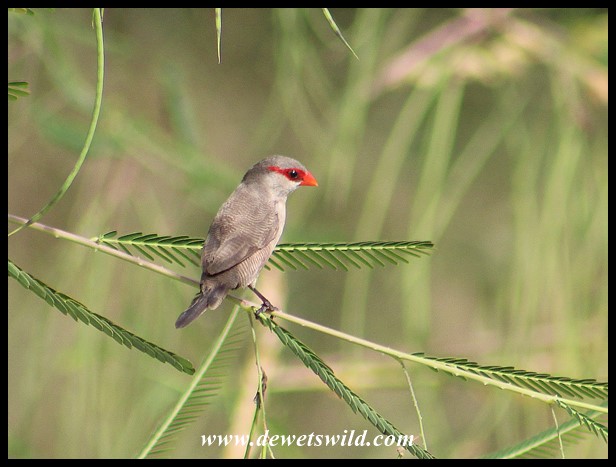Estrilda astrild
The Common Waxbill is an adaptable little finch that occurs in a wide-range of habitats, but is especially fond of densely growing vegetation in wetlands and along watercourses, and also enters gardens and parks in towns and cities. They’re social birds, moving around in flocks that usually number up to 50 individuals (though sometimes into the hundreds or even thousands) and feed mainly on grass flowers and seeds and the occasional soft-bodied insect.
Common Waxbills may breed throughout the year but predominantly during the warmer months of spring and summer. The male builds the intricate nest – a horizontal, pear-shaped construction of grass stems and leaves with a nesting chamber and a “dummy” nest cavity to confuse predators – that is usually placed on or near the ground at the base of thick vegetation. Both parents take turns to incubate the clutch of 4-6 (sometimes up to 9) eggs over a two-week period. The chicks fledge about three weeks after hatching, but often returns to the nest for a few days more to roost at night. Fully grown they weigh around 8g and measure up to 12cm long. The Common Waxbill is the main breeding host for the Pin-tailed Whydah, which lays 1-4 of their eggs in the nest of the Waxbill, often removing some or all of the Waxbill’s eggs, for the Waxbill to incubate their eggs and raise their chicks.
Common Waxbills have a patchy distribution over Sub-Saharan Africa; from Guinea in the west and Ethiopia in the northeast to South Africa, where it can be found in every one of our provinces. According to the IUCN, the Common Waxbill is of least concern. It is commonly found in the cage-bird trade and feral populations have become established in other parts of the world.



















Nice looking finch! Never heard of this bird before, It was nice to have met it. Thanks, D. 🙂
LikeLiked by 1 person
The pleasure was all mine, H.J!
LikeLiked by 1 person
What a beautiful bird! It may have “common” in its name, but it is far from that in my humble opinion 🙂 Hope you and your family are doing well.
LikeLiked by 1 person
Thank you, Takami. I agree with you that “common” is really not an apt description, no matter how numerous they are.
We’re well, thanks, and you?
LikeLiked by 1 person
Thank you Dries, I’m glad I’m not alone regarding the term “common” 🙂 We are also doing well – thanks so much for asking.
LikeLiked by 1 person
Are they finches, Dries?
They are quite like our red browed finch (Neochmia temporalis).
LikeLiked by 1 person
Yes, indeed, Tracy, and they’re also rather closely related to your red-browed finch.
LikeLiked by 1 person
I think the rbf have a bit more green on the tail and red under the tail than your common waxbill. They both look like bandits with that red mask.
LikeLiked by 1 person
We see these waxbills at Addo and have very occasionally had them visiting our garden. I am interested to see the one perching on what looks like a Verbena bonariensis in the Austin Roberts Bird Sanctuary. If that is what this plant is, it shouldn’t be allowed to grow freely there as it is classed as an invasive alien – there are a number of garden escapees around here, although the drought has ‘culled’ a lot that used to grow along the outskirts of town.
LikeLiked by 1 person
Given that Austin Roberts Bird Sanctuary is surrounded by affluent suburbs I wouldn’t bet against your id of the Verbena, Anne.
LikeLiked by 1 person
How very interesting to see and learn about this bird! My first reaction was that it was a female cardinal. Then I thought Cedarwaxwing. I have never seen a photo of a Common Waxbill before. Beautiful shots!
LikeLiked by 1 person
Thanks, Carol! Glad we could introduce you to them.
LikeLike
What a beauty this one is. The males and females have the same markings?
LikeLike
Quite right, Lois. There’s no discerning the male from the female out in the veld.
LikeLike
It´s a beautiful bird with the red beak. 🙂
LikeLiked by 1 person
They’re so tiny that you have to be really close to see the red on their beak and face.
LikeLike